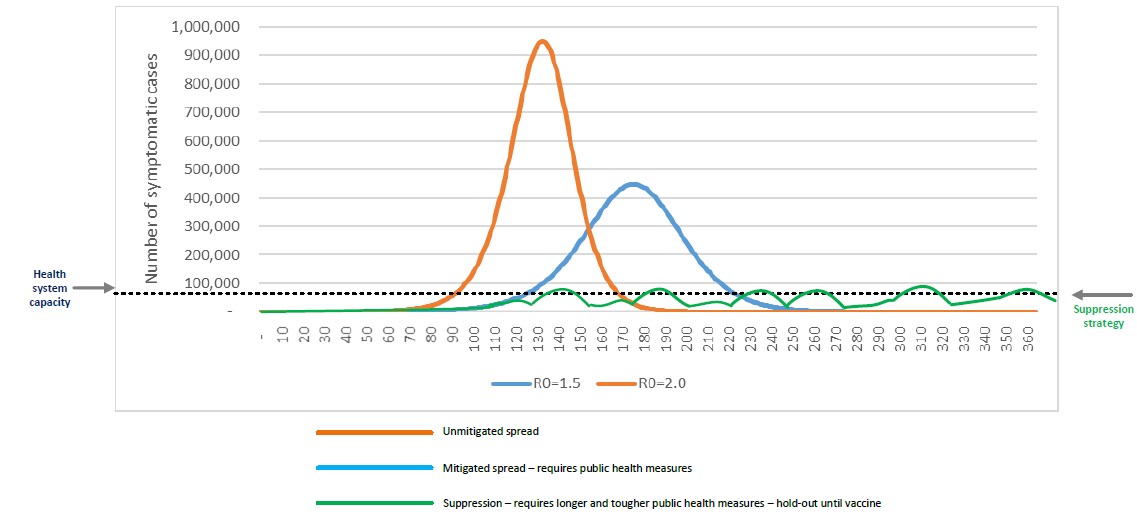How flat can you make a curve? The New Zealand approach to COVID-19
With so much uncertainty surrounding the immediate future in the face of COVID-19 we take a look at the government response and what this might mean for leaving home and returning to ‘normal’.
From CEOs making some of the toughest decisions of their careers to stay at home parents who want their kitchen table back, the question a lot of people are asking right now (the ones I have been in contact with from my self-isolation at least) is ‘how long is this lockdown going to last?’ The answer, how long is a piece of string, or more appropriately how much can you flatten a curve?
Most economists love forecasts and models and a number have tried to predict the future direction of COVID-19 and the global response, but with so many variables there is an infinite range of outcomes. As Dr Anthony Fauci, the director of the United States of America National Institute of Allergy and Infectious Diseases said “You’ve got to be realistic, and you’ve got to understand that you don’t make the timeline, the virus makes the timeline.” Although the virus makes the timeline, we make the conditions.
The lockdown strategy was instituted to break the chain of community transmission.
New Zealand will remain at COVID-19 alert level four until at least 22 April and many expect it will be longer than that. The lockdown strategy was instituted to break the chain of community transmission; that is, cases spread through everyday contact. When the virus first came to New Zealand it was exclusively identified in returning travellers and it was believed that it could be kept under control with contact tracing. However, once cases could no longer be traced back to returning travellers the ability to track and isolate potential cases was lost.
The decision to shift from a strategy of mitigation to one of elimination was taken to avoid a scenario of widespread outbreaks. The aim was to reduce the pressure on the health system, to avoid what is happening in Europe and now the United States.
Widespread outbreaks would lead to major health, economic and social impacts for New Zealand that could further devastate an economy
New Zealand’s approach has seen significant economic and social disruption, but if we are successful in eliminating COVID-19 from New Zealand we will have quicker positive economic and social outcomes in the long term. Widespread outbreaks would lead to major health, economic and social impacts for New Zealand that could further devastate an economy that becomes more fragile each day alert level four continues past 22 April.
The aim of moving to level four is to ensure that health system capacity is not exceeded through strengthening public health measures. On 30 March the All of Government Strategy and Policy Coordination Unit released the graph below showing their best estimate of what will happen as we try to contain and mitigate COVID-19.

The green line is what we are looking at with our current strategy. By taking this approach many lives will be saved and enough people remain well to operate essential services and the health care system. The orange and blue lines show the likely outcomes without the lockdown, where tough decisions will have to be made on who gets treatment and who doesn’t. The aim of the lockdown is to keep cases under the health system capacity, ensure everyone who needs treatments gets it, stop community transmission within New Zealand and keep it that way. Once we reach the point where it has been a set number of days since a new case is identified and we are below the health system line, then the countdown to easing restrictions is on.
A reduction in the alert level would mean some restrictions get lifted and some people could return to work. By allowing people to interact if COVID-19 remains circulating in the community might mean moving between alert levels and lockdowns will repeat itself. The number of times it repeats depends on how well we stick to the lockdown rules. When cases begin to increase again, restrictions will come back. Each time we increase restrictions more jobs will be lost. The fewer lockdowns required will mean fewer job losses, fewer deaths and more time living a normal life.
The alert level approach and keeping cases below health system capacity will need to be maintained until a vaccine is developed, which is at least January 2021, and/or the global pandemic has passed and most countries have eradicated COVID-19.
If we want to get back to normal we all need to continue to do the right things
This is not going to be a quick fix and will require monitoring for an extended period. But the answer is simple. The sooner we stop the transmission to COVID-19 in the community the sooner we can get back to what will be our new normal. If we want to get back to normal we all need to continue to do the right things such as washing our hands, staying home when sick, avoiding unnecessary contact and most importantly adhering to the instructions from government. As we saw at the beginning of this outbreak, all it takes is one person and we will be right back to where we are now. Don’t be that person.
If we can get COVID-19 under control, New Zealand will be in a much better position than many countries to limit the health and economic impact of the virus. With our main points of entry being our international airports, and with the right measures, we can control the entry of people back into the community and thus limit the potential for COVID-19 to re-enter New Zealand’s everyday life.
Photo credit: Ruth Vaughan.
Midland Park on a fine day in Wellington, would usually be packed with office workers enjoying their lunchbreak.